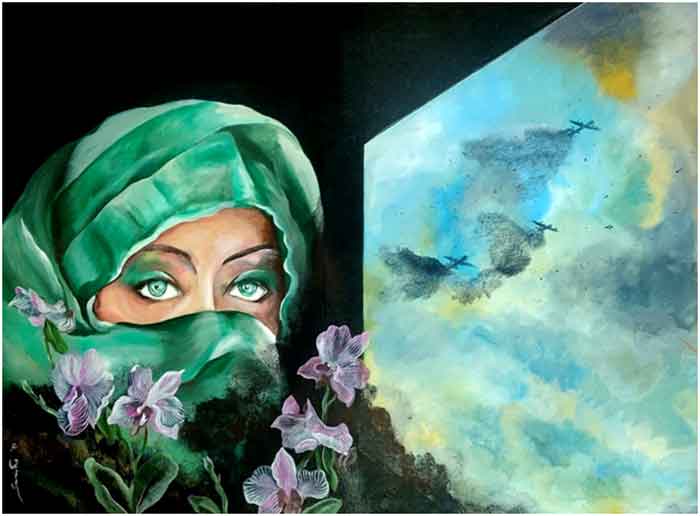
Painting of Afghan woman by Sarmistha Sarker
On a sunny Covid winter day, even while people waited for the third wave to fasten its grip, the Birla Academy of Art and Culture in Kolkata hosted a brilliant show of paintings, sound, images and light show, photographs and multi-layered aesthetic installations, created during the pandemic and lockdown by a group of fabulous artists.
Curated with scenography by Mukherjee P, and inaugurated by eminent sculptor Pankaj Panwar, the show, while reflecting the horrors and isolation of the times, was aptly termed: ‘Notes from the Lockdown… Annus Horribilis Twice Over.’
Indeed, the last two years of universal and individual horror, solitude and sadness, has created a huge body of work, in journalistic writings, academic and research papers, clinical texts, medical documentations, books, poetry and literature. However, this was perhaps the first major public rendition of a bottled-up phenomena, expressing the eternal dilemma, that despite an intense search for clarity and transparency, the twilight zones of ambiguity and ambivalence continue to stalk the work of sensitive art. And as always, when the entire world turns grey, colours find their great escape only through the brush of the artist, the camera of the photographer, and the melodies of the sound artist.
One of the works on display was that of Sarmistha Sarker, a deep and sensitive artist, painter and teacher, based in Kolkata. The chaos in Afghanistan after the Americans departed last year had left her restless for days. The gaze of the Afghan women, their dilemma and exile in their own land and landscape, haunted her. She could not sleep. She had to connect with them.
So, she picked up this huge canvas and started painting strong and tortured female faces, veiled and unveiled, looking out, looking at you, looking within, looking at the world, asking silent questions once again. “I was extremely disturbed. It is like an Anne Frank diary,” she says.
‘If you gaze for too long at the abyss, the abyss too will gaze at you’, wrote Fredrich Nietzsche. And if you gaze for too long without the veil at their faces, then they too shall gaze at you, from behind the veil. And yet it is so different – and this is no abyss.
Amidst the raging pandemic and dying, death and mass mourning, there was no lockdown in Afghanistan. Instead, it was the Taliban coming to power, which was worse than the pandemic. Especially for women.
 One child got lost in the chaos at the Kabul airport as thousands rushed for a getaway to escape the oppressive repeat of Taliban-rule in Afghanistan, with its pronounced prejudice and brutality against women. An American soldier took the child and gave it love and warmth.
One child got lost in the chaos at the Kabul airport as thousands rushed for a getaway to escape the oppressive repeat of Taliban-rule in Afghanistan, with its pronounced prejudice and brutality against women. An American soldier took the child and gave it love and warmth.
“I saw a picture of a young female marine in fatigue, a gun slung on her shoulder, holding an Afghan child in that chaos outside the airport – love, softness and compassion flowing out of her eyes, fingers and skin. Her gaze was beyond the airport, across the horizon, as if looking for signs of optimism and beauty in the rugged landscape amidst such sudden uncertainty. What was she thinking holding the child? Why was her gaze so lost, like the lost child itself? Was she the same woman who gave refuge to that lost little one in her arms, whose grieving parents have now discovered their child after so many months?”
There are Afghan women, in green, black and white, grey, inside twilight shadows, surrounded by scattered orchids like wild fruits in the expanse of the canvas, their gaze telling an eternal story of infinite despair and the will to live against all odds. Like Khaled Hossaini’s ‘A Thousand Splendid Suns’.
In a cold and freezing winter, often with no food and shelter, in drought like conditions, hopeless and helpless, abandoned by the world, trapped by male tyranny with guns, are they looking for a song: Here comes the sun…? Or, are they looking beyond the canvas, green eyes, light eyes, black eyes, darker and more beautiful than the dark side of the moon, hiding a zigzag zone of possibilities and daylight dreams unfulfilled, seeking a straw in the turbulent waters, looking for an oasis in the desert, thinking of the sun on a dreary, chilly midnight?
They move into the midnight and the paintings bring them to the morning of the light, and they move beyond the gallery in Covid times into yet another horizon of hope, like moon shadows, and purple orchids, and fingers and hands looking for other fingers and hands, for completion. There is enslavement and condemnation, but there is immense and intense freedom in their gaze; the inner strength of the angst and the anger on their beautiful faces is replete with the idea of liberation, individual and collective female liberation, the indomitable desire to fly into the sky on the wings of desire and beauty, optimism beyond despair, love beyond lovelessness, a woman beyond the man. She has hence moved beyond the canvas and made a place in our hearts, and her heart beats the resilient beat of a woman who knows how to live with courage and how to survive in a suffocating male, Taliban terrain of tyranny.
So when you see the women of Afghanistan, some of them without veils, some of them modern, educated, working professionals and liberated, wearing goggles, shouting slogans on the streets of Kabul, seeking fundamental rights, like the right to study and work, the right to travel and the freedom of movement without a male escort, the right to be part of the all-male government, the right to live — you know that the female gaze has transcended male myopia and carved its own, original niche of resistance and resilience.
Indeed, despite the abyss, they are refusing to look at it, nor is the abyss looking at them anymore. They are just out there on the streets, shouting slogans, like free women.
Suresh K Nair teaches art at the Banaras Hindu University (BHU). While in transit at an airport, having suffered once the paranoia and fear of the viral disease which he did not finally get, he started his process of creative catharsis on little cards, smaller than postcards, like visiting cards, drawing colourful sketches of multiple dance forms and the myriad movements of the human body in motion, thinking of his quaint little green and homely childhood village back in Kerala, wanting to send the postcards to all the inhabitants of this real and imagined homeland on this corner of the earth surrounded by the green of the Western Ghats and the shores of the Arabian Sea. So, he took this moment in transit as a creative project.
He drew hundreds of such cards, like pieces of a huge montage of a thousand bright and light and luminescent creatures in dance and movement, even as the world struggled in its static, stagnant, stasis of sustained suffering and solitude. And he sent many of them to the people in his village. A tribute to his childhood.
Sahaj Umang Singh Bhatia celebrated the great and glorious farmers’ movement beyond the borderlines of the borders outside the Indian capital where they set a gigantic and protracted example of collective sharing, bonding, struggle and stoicism against the fascist and repressive state machinery, and an arrogant and ruthless dictatorship, surrounded by a raging pandemic. His work is a living collage of photos, images, sound and light, with the resonant and deeply disturbing poetry of Adam Gondvi and Gorakh Pandey. The archaeology of protest is inspiring and inviting.
You can sit around a fire with the farmers, eat a roti in their community kitchens and langar, fix a plastic tarpaulin in rain, thunder, lightening and storm, print an original and revolutionary newspaper on a trolly, a truck or a tractor, visit the health centre to get free treatment and medicines, shout slogans and sing songs on the barricades, visit the little libraries, decode a pamphlet on the three farm laws, or read an essay by economist Prabhat Patnaik on the Indian peasantry. Or, simply, you can recite a poem which tells you to move out of the closed doors and the sheltered windows, and join the ‘jaloos’, the procession, the protracted protest, because the time to fight back has arrived.
This art show liberates the viewer from the suffocation of the times like the magic realism of love in the time of cholera. It narrates so many different and angular stories, like the sad, angular and intelligent portraits of women by Lalitha Lajmi, or the incredible series of ‘Free Gaza’ photographs from Occupied Palestine by Baishampayan Saha. Do people remember Palestine anymore in this pandemic? Did they get vaccinated finally, something systematically denied by the Israelis? Are they still killing the children out there with missiles? Are the check points and the huge wall of separation sill so brutally oppressive and alienating?
All the artists have poured their heart out in their own way, even in the empty, meditating expanse of a canvas by Shobha Broota, or the solitary Coffee Cup by EH Pushkin, his name also a lovely reminder of a great poet in Tsarist Russia who joined the ‘Decembrist uprising’ and, later, died in a duel. The other artists included Kanchan Chander, Jamil Ahmed Khan, Instabili Vaganti, Lochan Upadhyay, Shailesh BR, and Budhaditya Chattopadhyay. The show started on November 19 and ended on December 24. However, the gaze of the beautiful and resilient Afghan women still remains alive and alone, individual and collective, steadfast and serene. As the curator of the show says, “We live in hope.”
Amit Sengupta is Executive Editor, Hardnews and a columnist, currently based in Kolkata














































